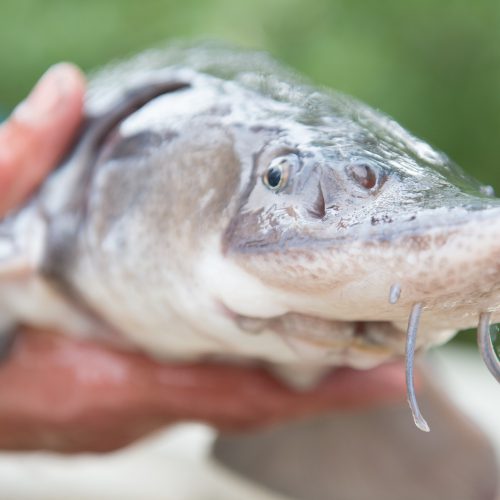News
Sterlet release at Ceršak
WWF, together with local NGOs, released 30 sterlets into the Mura River to highlight the importance of the Mura River for the conservation of fish species, as it is the river with the greatest fish biodiversity in Slovenia: two thirds of Slovenian fish species can be found here. Before the release, the sterlets were tagged with specific T-tags, which will allow the tracking of the animals, which will provide data so see how they thrive in their new habitat.
The greatest threat to the Mura River, and the species that live in and around it, are the planned hydropower plant at Hrastje-Mota and seven additional hydropower power plants further downstream.
"The sterlet release was part of the campaign “Save the Mura”, which urge the Ministry of Environment and Spatial Planning, not to allow the destruction of this Slovenian and European natural treasure and stop plans to build hydroelectric power plants along the Mura. These would lead to the extinction of almost half of the indigenous fish species and would be a major threat to the already small population of sterlets, as well as other migratory fish, such as the huchen and the nase, which would also disappear fast, " said Andrew Slameršek, campaign coordinator for WWF.
For more than 10 years now, the Drava power plants (DEM) would like to turn the Mura into a chain of hydropower plants and reservoirs. The first, out of eight, is planned at the village of Hrastje-Mota, for which a comprehensive environmental impact assessment was developed in 2012 and the final decision by the Ministry of Environment and Spatial Planning is expected this year. The construction site for the hydropower dam is a Natura 2000 site and the core of the Slovenian part of the transboundary UNESCO Biosphere Reserve “Mura-Drava-Danube".
The construction of hydropower dams would irreversibly damage the habitats of 19 native fish species, which would in turn lead to the disappearance in the long-term. Hydropower dams cause fluctuations of the water level, which prevents spawning and increases in water temperature, and therefore pose a major threat to native fish. Fishermen already had bad experiences along the Drava River, where the construction of hydropower dams lead to a great decline in native fish species. The negative impacts of hydropower plants will also be visible in other areas, such as the contamination of groundwater, the accumulation of heavy metals in the sludge and the build-up of methane," said Dr. Miroslav Žaberl, President of the Fishermen’s Association of Slovenia.
"Sterlets are a migratory fish species each year some of them are caught along the Mura, which proves that they are still migrating to Slovenia from the Croatian part of the Drava River, and even from the Danube. On the way from the Danube they migrate to the Croatian-Serbian border, all the way to Spielfeld in Austria, without any barriers. With the construction of the hydropower dam at Hrastje-Mota, this unique river corridor would be interrupted and irreparable damage caused to the unique fish biodiversity in Slovenia," said Arno Mohl from WWF Austria.
"In Slovenia, two of the three major rivers are dammed, only the Mura is the last Slovenian lowland river without hydropower dams, which should remain like this in the future. We must preserve our last natural rivers for future generations and not destroy them in the favour of short-term interests," said Rok Rozman, Olympian kayaker, leader of the “Balkan Rivers Tour” project and ambassador of the Mura River.
A video about the release can be viewed here




